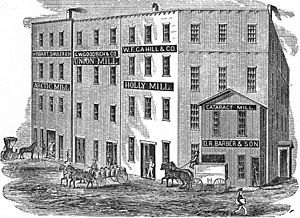Charles M. Loring facts for kids
Quick facts for kids
Charles M. Loring
|
|
|---|---|
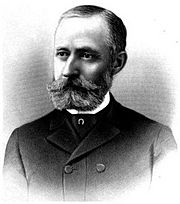 |
|
| Born | November 13, 1833 Portland, Maine, US
|
| Died | March 18, 1922 (aged 88) Minneapolis, Minnesota, US
|
| Occupation | Businessperson, miller, park commissioner, grain trader |
Charles Morgridge Loring (born November 13, 1833 – died March 18, 1922) was an important American businessman. He was a miller and a publicist. Even though he grew up in Maine expecting to be a sea captain, Loring became a leader in Minneapolis, Minnesota.
In Minneapolis, he was a rich flour miller. He also helped build the first city hall in Riverside, California. Loring was known as a kind and generous person. He had many friends and business partners.
People remember Loring best for his work with the first Minneapolis park board. He was called the "Father of the Park System" in Minneapolis. Loring encouraged the city to work with Horace Cleveland, a famous landscape architect. He also worked with park superintendents William W. Berry and Theodore Wirth. Together, they created an amazing public park system.
Contents
Charles Loring's Early Life and Family
Loring's grandfather was a respected teacher in Portland, Maine. His family came from early settlers in Hingham, Massachusetts. Charles was a fifth great-grandson of Deacon Thomas Loring. His mother, Sarah Wiley, was related to a well-known clergyman.
His father, Captain Horace Loring, was a seaman. He took young Charles on trips to places like Cuba. This was to prepare him to be a sea captain. But Loring did not like the ocean or being alone.
In 1856, he moved to Chicago. There, he became a successful grain trader. He worked for B. P. Hutchinson.
Loring often had health problems. When he got sick in Chicago, his doctor told him to move to Minneapolis. His friend Loren Fletcher helped him. Loring became the manager of a supply store for Dorilus Morrison's lumber business.
Loring married Emily S. Crosman in 1855. They had a daughter, Eva Maria, and a son, Albert C. Loring. Albert later managed his father's businesses. Emily Loring passed away in 1894. Loring married Florence Barton in 1895.
Florence Loring was also active in community work. She was a quilter, and her Crazy Quilt is now in the Minneapolis Institute of Art. In 1906, the Lorings built the Florence Barton Loring Shelter. This shelter helped children, lost animals, and city draft horses. Today, it is part of the Animal Humane Society (AHS). Florence also built a home for nurses in Riverside, California, where the Lorings spent their winters.
Flour Milling Business
Minneapolis was built near Saint Anthony Falls. This was the only waterfall on the Mississippi River. The falling water created a lot of energy. Loring understood how to use the city's unique geography. He used the waterfalls, lakes, and river banks to build his wealth.
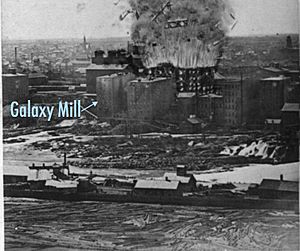
In 1861, Loring joined L. Fletcher & Co. This was a general store on Nicollet Avenue. They sold supplies for lumbermen. They did well for fifteen years. They worked with W. F. Cahill to turn a waterworks building into a flour mill. It was the smallest mill in the area.
They added three stories and called it the W. F. Cahill & Co. Holly mill. During this time, Loring also worked in the city government. He was a road supervisor and later a Minneapolis City Council member.
In 1872, the group sold the Holly mill. They bought the Galaxy mill. In 1873, Fletcher and Loring also became main owners of the Minnetonka Mills Company. Loring oversaw his milling businesses until 1880. Then, his son A. C. Loring took over.
Later, the Northwestern Consolidated Milling Company bought the Galaxy mill. By the early 1900s, large companies like General Mills and Pillsbury-Washburn controlled most of the flour market in Minneapolis.
Electricity and Railroads

Loring also helped improve Minneapolis's infrastructure. He helped bring electricity to the city. He was a director of a railroad company. He was also the chief executive of the North American Telegraph Company.
In 1881, Loring and others started the Minnesota Electric Light and Electric Motive Power Company. This company later became the Minnesota Brush Electric Company. They built lines to businesses on Washington Avenue. They supplied power from the first hydroelectric power plant in the U.S. This was 13 years before the famous Niagara Falls plant opened.
In 1883, Loring and other leaders started the Minneapolis Sault Ste. Marie & Atlantic Railway Company. This company is known as the Soo Line Railroad.
Other Businesses and Groups
Loring also owned real estate. He was a director for several insurance and trust companies. One of these companies later became part of today's Wells Fargo.
Loring helped organize the first Minnesota Flower Show in 1863. He was a member of the Minnesota Horticultural Society. He also helped start the Minnesota Homœopathic Medical College in 1886. Loring was president of the Minneapolis Board of Trade in 1875. From 1886 to 1890, he was president of the Minneapolis Chamber of Commerce, which is now the Minneapolis Grain Exchange.
Loring also helped start the Morgan Machine Co. in Rochester, New York. He was president of several groups, including the Minnesota Forestry Association and the National Park and Outdoor Association. He was also president of the Lakewood Cemetery Association.
Minneapolis Park Board
In 1883, the Minneapolis Board of Trade voted to create a Board of Park Commissioners. The city approved this idea on April 3, 1883. Loring was the perfect choice to lead it. He was named the commission's first president. He was reelected many times. He served until 1890, when he decided to resign. He resigned because a property he owned was being considered by the park board.
Working with Horace Cleveland
Horace Cleveland did some of his best work in Minneapolis. He worked with people who shared his love for nature. William Watts Folwell, the first president of the University of Minnesota, and Berry and Loring, both from Maine, all loved nature.
Cleveland designed a park system that used native plants in their natural settings. He also connected open spaces and landmarks with boulevards and parkways. He had thought about linking public open spaces as early as 1855.
During Loring's time, Cleveland designed the Grand Rounds Scenic Byway and the Chain of Lakes. Loring wrote about how green spaces were saved around every Minneapolis lake. Many properties were bought early, so the land was affordable. For example, in 1872, the city thought $50,000 was too much for 250 acres (1.0 km²) around Lake Harriet. Thirty years later, it would have cost $2,000,000.
Minnehaha Park
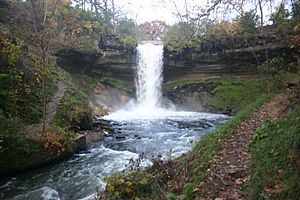
By the 1870s, many people visited Minnehaha Falls. They were fans of Henry Wadsworth Longfellow's poem The Song of Hiawatha. At the same time, business people wanted to use the waterfall's power.
In 1884, Loring wanted to make Minnehaha Falls a state park in Minnesota. The state tried but could not do it. In 1888, Cleveland gave a speech about developing parks in Minneapolis and St. Paul. He convinced the city to save the waterfall and build a city park there. In the 1890s, Minnehaha Park became part of Minneapolis. It completed the Grand Rounds.
Today, Minnehaha Park gets 850,000 visitors each year. The 52-mile (83 km) Grand Rounds circles the city. It goes from Northeast, Minneapolis to Theodore Wirth Park, around the Chain of Lakes, and along the Mississippi River past Minnehaha Falls.
Working with Theodore Wirth
In 1889, Loring read Cleveland's paper, The Influence of Parks on the Character of Children. In 1905, Loring learned about Theodore Wirth. He hired Wirth as the park superintendent. Wirth worked with Minneapolis neighborhoods. He extended Cleveland's ideas from big landmarks to every street.
Wirth created "sixty miles of picturesque parkways around the City like an emerald ribbon." He planned playgrounds that most children could reach. He also planned for many trees throughout the city. Today, every home in Minneapolis is within six blocks of a park. In 2000, there were 770 sq ft (72 m²) of parkland for each person.
As of 2004, Minneapolis had many park assets. 144 of these parks were already there when Wirth retired in 1935.
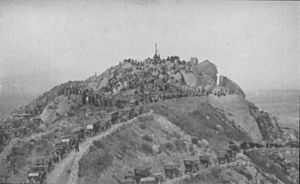
|
|
|
Riverside, California
In 1889, Loring built an office block in his winter home of Riverside, California. The first floor had a 1,000-seat theater. Famous performers like W. C. Fields and Sarah Bernhardt performed there. The theater was known by different names, including the Loring Opera House. It was destroyed by fire in 1990.
The office building was rented to the city. It was used as Riverside's first City Hall. It also held the library, jail, and municipal courts.
Loring's Legacies
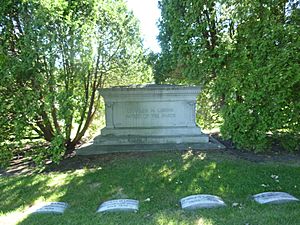
Loring Park in Minneapolis is 35 acres (14 ha). It was designed by Cleveland. It was dedicated in 1883 and later renamed for Loring. Loring Lake, which used to be Johnson Lake, was also named after him. The Loring Stage House, originally Loring's office, also carries his name.
In California, Loring Drive in Huntington Park and Loring's building in Riverside were named for him. In Minneapolis, the Loring Elementary School and the Loring Nicollet Alternative School are named after him. The Loring Pasta Bar in Dinkytown and other businesses also use his name. The Minneapolis Park & Recreation Board has a Charles M. Loring Award.
The Camp Fire Girls planted a spruce tree in his memory. It is on the south shore of Lake Harriet.
Loring passed away at his home in Minneapolis when he was 88 years old. He is buried in Lakewood Cemetery. He helped create this cemetery near Lake Calhoun in Minneapolis. The City of Riverside declared April 17, 1923, "Loring Day." They dedicated a plaque to him with this message:
In honor of
Charles M. Loring
Treelover
And
Civic Enthusiast
Let dead names be eternalized by dead stones
Let living names by living shafts be known:
Plant thou a tree whose griefless leaves shall sing
Thy deed and thee, each fresh unfolding spring


